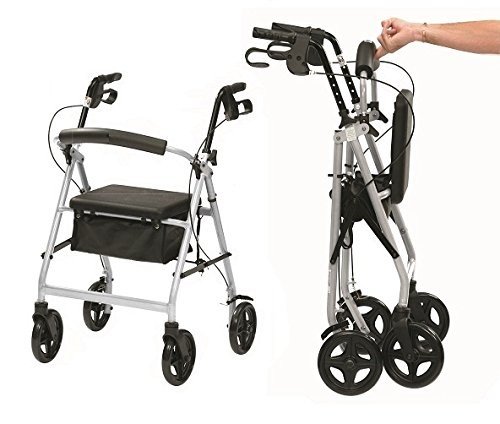This company has no active jobs
0 Review
Rate This Company ( No reviews yet )
About Us
Guide To Rollator With Wheels: The Intermediate Guide In Rollator With Wheels
Understanding Rollators with Wheels: A Comprehensive Guide
Rollators, also called wheeled walkers, have actually become significantly popular among individuals seeking mobility help. These innovative gadgets provide a mix of support, stability, and convenience, making them perfect for seniors and people with disabilities. This short article checks out the features, benefits, types, and considerations of rollators with wheels, along with regularly asked questions to assist you make an informed decision.
What is a Rollator?
A rollator is a mobility device equipped with three or 4 wheels, hand brakes, and a frame created for stability. Unlike conventional walkers, which need users to raise the gadget to move, rollators slide smoothly, permitting users to walk naturally while receiving assistance. The majority of rollators also consist of a seat for resting, making them especially beneficial for those who might tire quickly.

Secret Features of Rollators
- Wheels: Generally developed with either 3 or four wheels, offering balance and stability while walking.
- Hand Brakes: These brakes enable users to stop the rollator safely while promoting confidence during use.
- Seat: Many rollators come geared up with a seat for resting, perfect for users who might need to take breaks during strolls.
- Basket or Storage Bag: Convenient for carrying personal products, shopping, or basics during trips.
- Adjustable Height: Frames are often adjustable for a custom-made fit, accommodating users of numerous heights.
Benefits of Using a Rollator with Wheels
Rollators offer various benefits for people with limited mobility. Some of the key benefits include:
- Enhanced Mobility: Rollators allow users to maintain self-reliance and mobility, making it much easier to navigate inside and outdoors.
- Enhanced Stability: The presence of wheels and brakes offers additional assistance, reducing the risk of falls.
- Benefit of Use: Users can walk naturally without needing to lift the device, which can alleviate strain on the arms and back.
- Comfortable Seating: Users can take breaks whenever required, reducing tiredness and allowing longer trips.
- Increased Confidence: With better support and stability, users may feel more safe in their movements, leading to higher mobility.
Kinds of Rollators
When thinking about a rollator, a range of options are available to deal with varied needs:
-
Standard Rollators: Typically included four wheels, bigger frames, and a comfy seat, making them appropriate for a lot of users.
-
Compact Rollators: Designed for indoor use or travel, these rollators are lightweight, foldable, and often feature smaller sized frames.
-
Sturdy Rollators: Engineered for users who may need extra support, these rollators usually have a higher weight capability and a bigger frame.
-
Three-Wheeled Rollators: More maneuverable than their four-wheeled counterparts, these rollators are perfect for navigating tighter spaces.
Factors to consider Before Purchasing a Rollator
Before investing in a rollator, there are several aspects that should be thought about to ensure the very best fit for specific requirements:
- Weight Capacity: Check the weight limitation to ensure it supports the user’s weight effectively.
- Frame Size: Ensure that the frame fits the user’s height for optimal convenience and assistance.
- Wheel Size: Larger wheels are typically better for outdoor use and rough surface, while smaller sized wheels are more fit for indoor use.
- Storage Options: Consider how much storage is essential for mobility aids, shopping, or individual products.
- Portability: If travel is a top priority, go with a foldable and lightweight design for ease of transportation.
Upkeep of Rollators
Proper upkeep can extend the life of a rollator and ensure safety throughout use. Here are some ideas:
- Regularly Check Brakes: Ensure that hand brakes operate appropriately and adjust them as required.
- Inspect Wheels: Look for wear and tear; replace wheels if they show signs of damage.
- Tighten Loose Parts: Regularly inspect for any loose screws or bolts and tighten them to maintain stability.
- Clean the Frame: Wipe down the frame frequently to keep it totally free from dirt and debris.
Table: Comparison of Rollator Types
| Kind of Rollator | Wheel Count | Suitable Use | Weight Capacity | Mobility |
|---|---|---|---|---|
| Requirement Rollator | 4 | General mobility | 300 lbs | Moderate |
| Compact Rollator | 4 | Indoor/Travel | 250 pounds | High |
| Durable Rollator with wheels | 4 | Rigorous use | 400 pounds | Low |
| Three-Wheeled Rollator | 3 | Tight areas | 300 lbs | Moderate |
FAQs About Rollators with Wheels
Q1: How do I pick the best rollator for my needs?
A1: Consider elements such as your height, weight, and where you’ll mainly use the rollator (indoor vs. outdoor). A trial at a mobility store may also help you discover a comfy fit.
Q2: Are rollators challenging to maneuver?
A2: Most rollators are designed for ease of use, and with practice, users usually find them easy to maneuver, especially those with turning wheels.
Q3: What is the typical expense of a rollator?
A3: Prices can vary significantly, from around ₤ 70 for standard designs to over ₤ 300 for high-end or specialized models.
Q4: Can rollators be utilized outdoors?
A4: Yes, numerous rollators are developed for both indoor and outdoor use. Nevertheless, selecting one with larger wheels can enhance stability on unequal surface.
Q5: How do I maintain my rollator?
A5: Regularly inspect the brakes and wheels for wear, tighten up any loose parts, and clean the frame periodically to guarantee safety and longevity.
Rollators with wheels are important mobility aids that promote self-reliance and security for users. By comprehending the features, benefits, and maintenance of rollators, individuals can make informed choices about their mobility needs. With the best rollator, users can delight in enhanced mobility, confidence, and quality of life.



